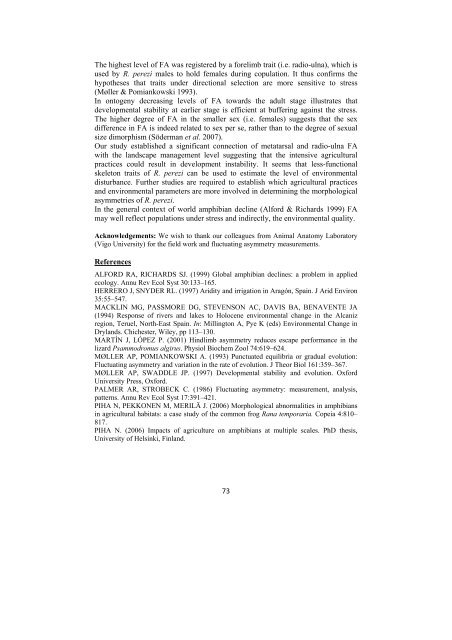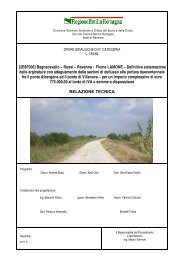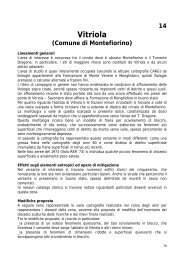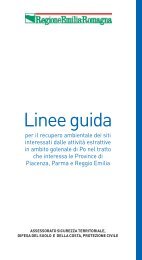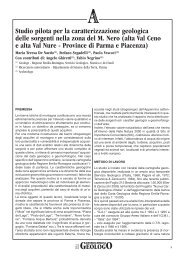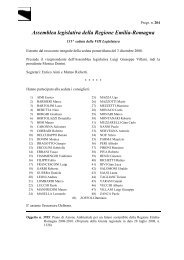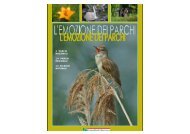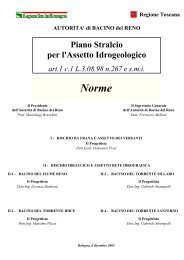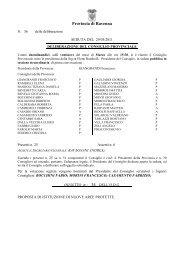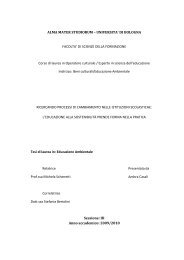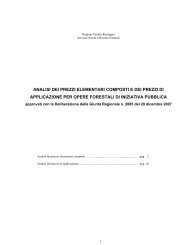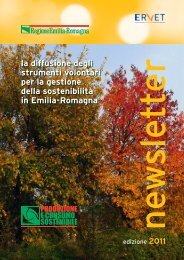air, water and soil quality qualité - ER Ambiente - Regione Emilia ...
air, water and soil quality qualité - ER Ambiente - Regione Emilia ...
air, water and soil quality qualité - ER Ambiente - Regione Emilia ...
You also want an ePaper? Increase the reach of your titles
YUMPU automatically turns print PDFs into web optimized ePapers that Google loves.
The highest level of FA was registered by a forelimb trait (i.e. radio-ulna), which is<br />
used by R. perezi males to hold females during copulation. It thus confirms the<br />
hypotheses that traits under directional selection are more sensitive to stress<br />
(Møller & Pomiankowski 1993).<br />
In ontogeny decreasing levels of FA towards the adult stage illustrates that<br />
developmental stability at earlier stage is efficient at buffering against the stress.<br />
The higher degree of FA in the smaller sex (i.e. females) suggests that the sex<br />
difference in FA is indeed related to sex per se, rather than to the degree of sexual<br />
size dimorphism (Söderman et al. 2007).<br />
Our study established a significant connection of metatarsal <strong>and</strong> radio-ulna FA<br />
with the l<strong>and</strong>scape management level suggesting that the intensive agricultural<br />
practices could result in development instability. It seems that less-functional<br />
skeleton traits of R. perezi can be used to estimate the level of environmental<br />
disturbance. Further studies are required to establish which agricultural practices<br />
<strong>and</strong> environmental parameters are more involved in determining the morphological<br />
asymmetries of R. perezi.<br />
In the general context of world amphibian decline (Alford & Richards 1999) FA<br />
may well reflect populations under stress <strong>and</strong> indirectly, the environmental <strong>quality</strong>.<br />
Acknowledgements: We wish to thank our colleagues from Animal Anatomy Laboratory<br />
(Vigo University) for the field work <strong>and</strong> fluctuating asymmetry measurements.<br />
References<br />
ALFORD RA, RICHARDS SJ. (1999) Global amphibian declines: a problem in applied<br />
ecology. Annu Rev Ecol Syst 30:133–165.<br />
H<strong>ER</strong>R<strong>ER</strong>O J, SNYD<strong>ER</strong> RL. (1997) Aridity <strong>and</strong> irrigation in Aragón, Spain. J Arid Environ<br />
35:55–547.<br />
MACKLIN MG, PASSMORE DG, STEVENSON AC, DAVIS BA, BENAVENTE JA<br />
(1994) Response of rivers <strong>and</strong> lakes to Holocene environmental change in the Alcaniz<br />
region, Teruel, North-East Spain. In: Millington A, Pye K (eds) Environmental Change in<br />
Dryl<strong>and</strong>s. Chichester, Wiley, pp 113–130.<br />
MARTÍN J, LÓPEZ P. (2001) Hindlimb asymmetry reduces escape performance in the<br />
lizard Psammodromus algirus. Physiol Biochem Zool 74:619–624.<br />
MØLL<strong>ER</strong> AP, POMIANKOWSKI A. (1993) Punctuated equilibria or gradual evolution:<br />
Fluctuating asymmetry <strong>and</strong> variation in the rate of evolution. J Theor Biol 161:359–367.<br />
MØLL<strong>ER</strong> AP, SWADDLE JP. (1997) Developmental stability <strong>and</strong> evolution. Oxford<br />
University Press, Oxford.<br />
PALM<strong>ER</strong> AR, STROBECK C. (1986) Fluctuating asymmetry: measurement, analysis,<br />
patterns. Annu Rev Ecol Syst 17:391–421.<br />
PIHA N, PEKKONEN M, M<strong>ER</strong>ILÄ J. (2006) Morphological abnormalities in amphibians<br />
in agricultural habitats: a case study of the common frog Rana temporaria. Copeia 4:810–<br />
817.<br />
PIHA N. (2006) Impacts of agriculture on amphibians at multiple scales. PhD thesis,<br />
University of Helsinki, Finl<strong>and</strong>.<br />
<br />
73


